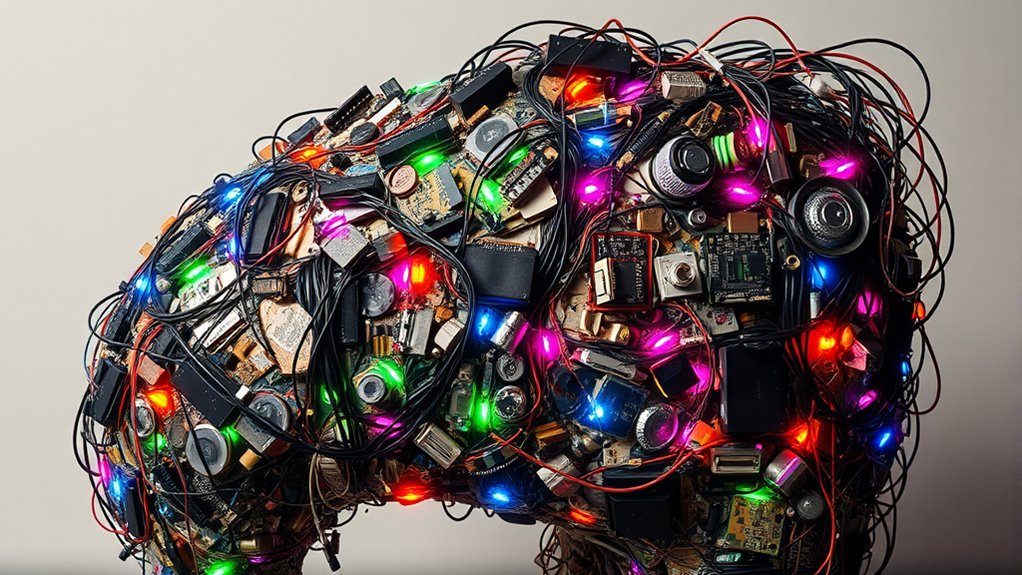Discover how hidden gems emerge when you upcycle e-waste into art. By transforming discarded smartphones, circuit boards, and other electronic parts, you not only promote sustainability but also challenge disposable culture. This creative process allows you to craft powerful symbols that reflect technological progress and social values. If you keep exploring, you’ll find inspiring examples of resourcefulness and eco-conscious artistry that turn waste into meaningful cultural statements.
Key Takeaways
- Upcycling e-waste into art transforms discarded gadgets into meaningful symbols that promote sustainability and challenge disposable culture.
- Artists utilize complex electronic components like circuit boards and smartphones to create innovative, thought-provoking artworks.
- Repurposing e-waste reduces environmental impact by conserving resources and minimizing landfill accumulation.
- Creating e-waste art requires technical skills such as delicate soldering, dismantling, and understanding electronic intricacies.
- These artworks serve as cultural reflections, evoking nostalgia, social commentary, and emphasizing the importance of sustainable resource management.

As electronic waste continues to pile up globally, more artists are transforming discarded gadgets into stunning works of art. This practice not only addresses environmental concerns but also invites viewers to reconsider the cultural symbolism embedded in everyday technology. When you upcycle e-waste into art, you tap into a narrative that challenges the disposable culture rooted in rapid technological advancement. Gadgets like old smartphones, circuit boards, and broken monitors become symbols of a bygone era’s innovation and excess, now repurposed to provoke reflection on consumerism and sustainability. By doing so, you create pieces that resonate culturally, reminding us of the fleeting nature of technological trends and the importance of giving new life to what’s considered obsolete. These artworks often evoke nostalgia, social commentary, or a sense of technological progress, transforming discarded items into meaningful symbols that speak to collective consciousness. Engaging in upcycling also encourages sustainable resource management by reducing waste and conserving raw materials used in manufacturing. However, turning e-waste into art isn’t without technical challenges. You must navigate the intricacies of working with complex, often fragile, electronic components. Soldering tiny circuits, handling sharp edges, and ensuring safety from residual hazardous materials demand skill and precision. It’s essential to understand the internal workings of gadgets to dismantle them effectively, avoiding damage to valuable parts or creating unsafe conditions. You might encounter difficulty in sourcing compatible components or finding the right adhesives and tools to assemble your piece securely. Additionally, designing with electronic parts requires an innovative approach to overcome their inherent limitations — such as limited size, weight, or the inability to withstand certain environmental conditions. You also face the challenge of preserving the integrity of the original components while reconfiguring them into new forms, striking a balance between aesthetic appeal and technical feasibility. Despite these hurdles, the process of upcycling e-waste into art pushes your creativity and technical skills to new heights. It’s a demanding but rewarding endeavor that demands patience, research, and adaptability. You learn to see potential in what others discard, transforming it into powerful statements that challenge perceptions. Your work becomes a fusion of art and technology, demonstrating that even the most complex and seemingly unusable parts can have a second chance at life. Ultimately, by addressing these technical challenges head-on, you contribute to a meaningful dialogue about environmental responsibility and cultural symbolism, reminding everyone that beauty and significance can emerge from the most unlikely sources.
Frequently Asked Questions
How Do Artists Source E-Waste Materials Ethically?
When sourcing e-waste materials ethically, you should prioritize transparency and responsible practices. Engage with local communities and organizations to ensure proper disposal and recycling of electronics. Verify suppliers’ commitment to ethical sourcing, avoiding e-waste from illegal or unsafe sources. By involving communities in collection efforts, you support fair practices and promote environmental sustainability. This approach not only guarantees ethical sourcing but also bolsters community involvement in your art projects.
What Safety Precautions Are Necessary When Handling E-Waste?
When handling e-waste, you need to prioritize safety due to hazardous materials like heavy metals and chemicals. Always wear protective gear such as gloves, goggles, and masks to prevent exposure. Make sure you’re working in a well-ventilated area and avoid direct contact with the hazardous materials. Proper disposal of waste and handling tools carefully also help minimize risks, ensuring you stay safe while transforming e-waste into art.
Are There Legal Restrictions on E-Waste Art?
Did you know that many countries have strict laws on e-waste? When creating e-waste art, you must guarantee legal compliance, including proper disposal and recycling standards. You also need to respect intellectual property rights—using someone else’s designs or branded components without permission can lead to legal issues. Always research local regulations and obtain necessary permits to avoid fines or confiscation, ensuring your art project stays lawful and ethical.
How Durable Are Upcycled E-Waste Art Pieces?
You might wonder about the durability of upcycled e-waste art. Generally, the material longevity depends on the types of e-waste used and how it’s assembled. Proper sealing and preservation techniques can enhance its durability. Keep in mind, this art has a positive environmental impact by repurposing waste, but if not cared for, it may degrade faster. So, maintaining it helps balance durability and environmental benefits.
Can E-Waste Art Be Recycled Again?
You might wonder if e-waste art can be recycled again. The answer is yes, especially when you focus on electronic aesthetics and sustainable creativity. Many artists design their pieces with recyclable materials or easily separable components, enabling future reuse or recycling. By choosing eco-friendly methods, you help reduce waste and promote sustainability, ensuring your art continues to inspire while being environmentally responsible.
Conclusion
So, seize the sustainable spirit, spark your creativity, and transform trash into treasures. Upcycling e-waste isn’t just about reducing rubbish; it’s about revealing remarkable, recycled masterpieces. By bravely bridging boundaries between waste and wonder, you become part of a powerful, positive change. Let your imagination ignite innovation, and turn discarded devices into dazzling displays of design. Together, you can create enthralling art while championing change—because every piece of e-waste is an opportunity for extraordinary expression.









